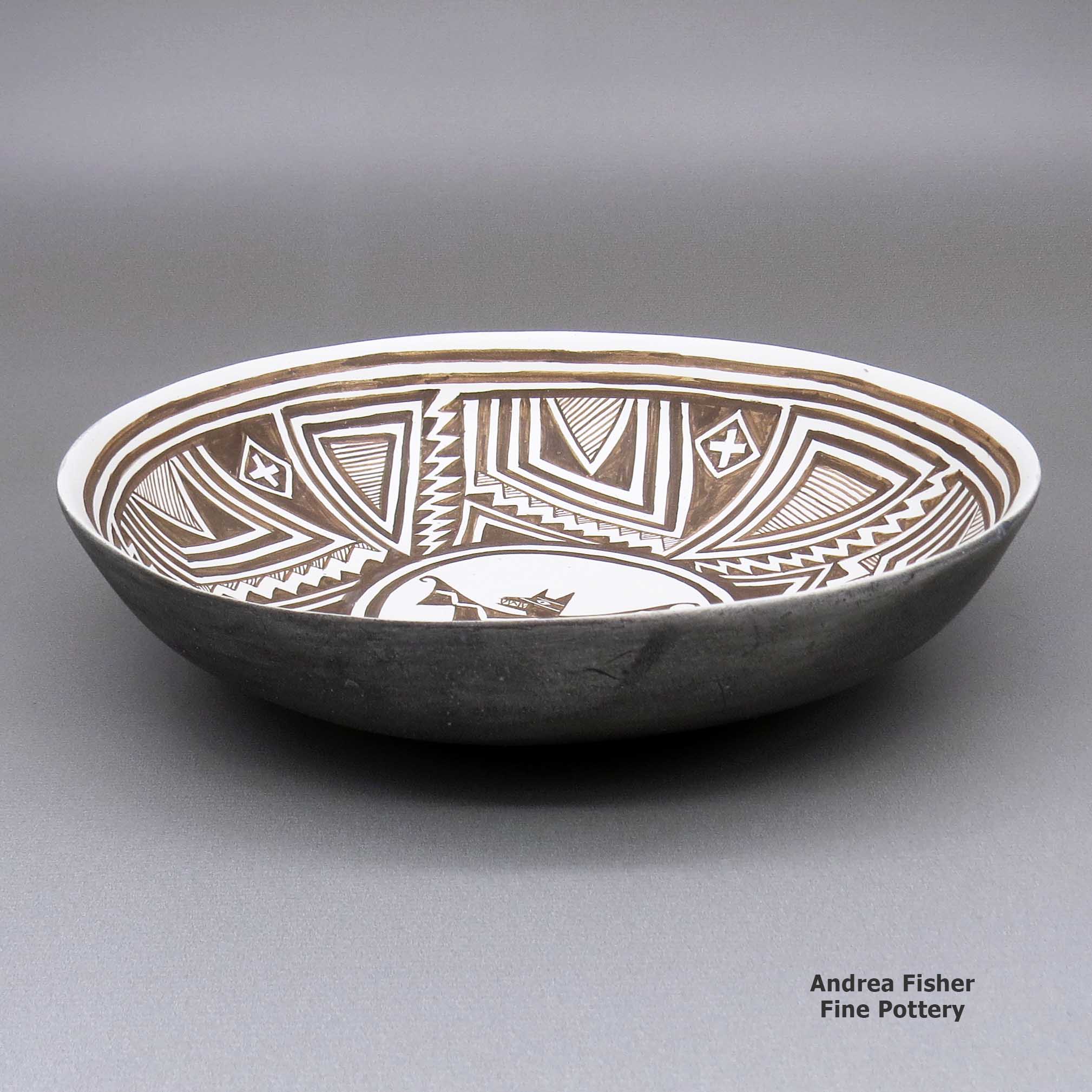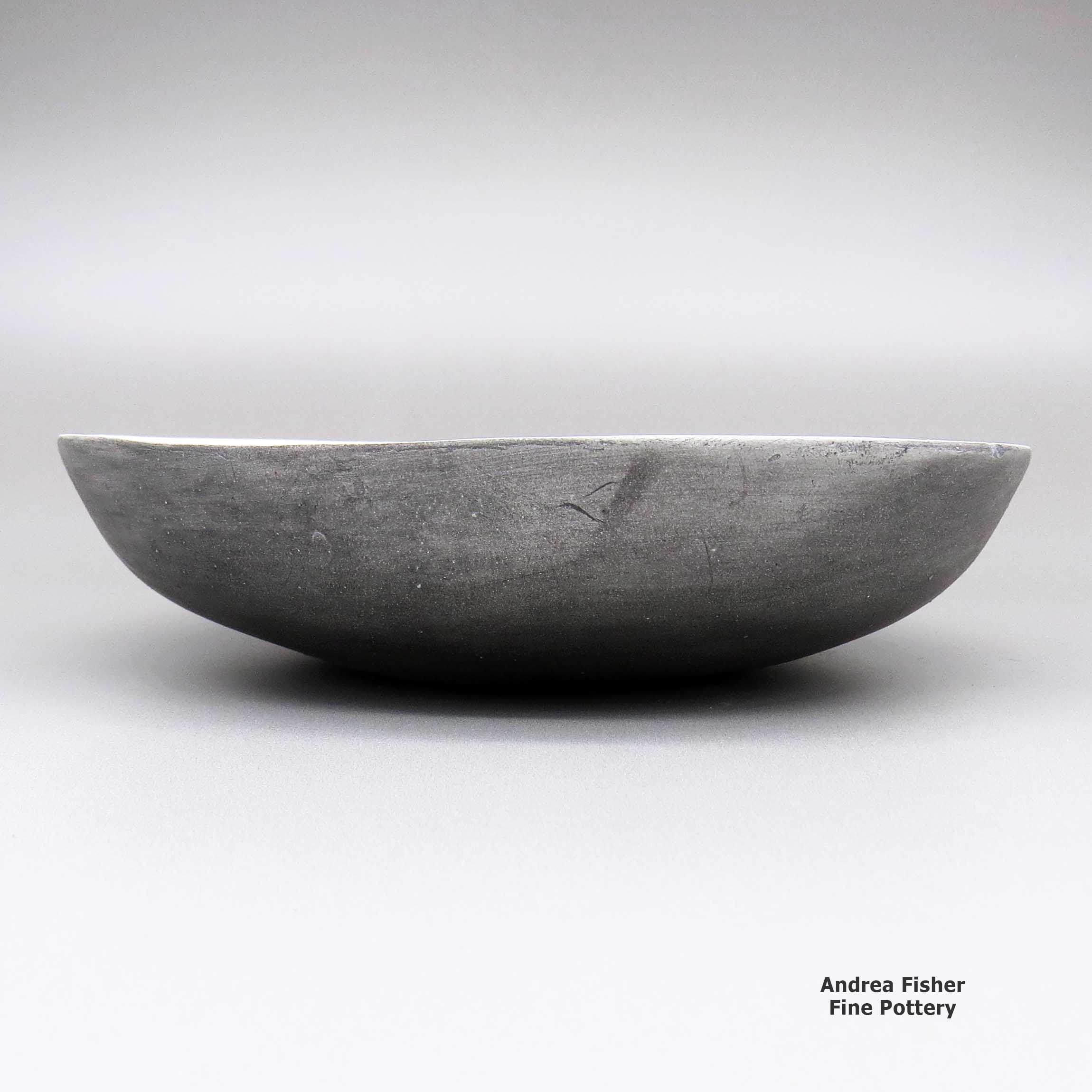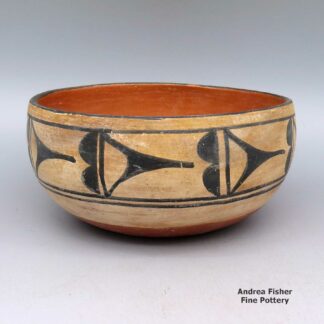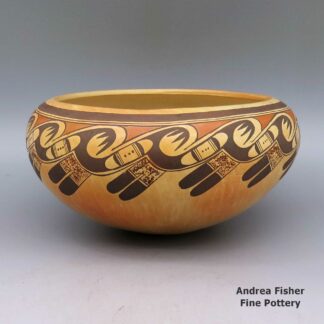| Dimensions | 7.75 × 7.75 × 1.75 in |
|---|---|
| Condition of Piece | Excellent |
| Date Born | 2023 |
| Signature | Isleta W/T KD, with hallmarks |
Kimo DeCora, zzle3b281, Black and white bowl with a Mimbres bat and geometric design
$1,200.00
A black-on-white bowl decorated with a Mimbres bat and geometric design
In stock
Brand
DeCora, Kimo
After finishing high school, Kimo attended Haskell Indian Nations University and studied off-set lithography. He became a certified off-set pressman, then ten years later he got interested in painting. At first he drew his inspiration from his love of the outdoors. Then he started to connect with ancient Anasazi and Mimbres ruins and some of the artifacts he found there.
He learned the basics of traditional pottery making on his own but he also learned through watching Cipriano Romero Medina and John Montoya at work.
Kimo's favorite shapes to make are bowls, jars, small owls and his trademark miniatures. Over the years his pieces have earned him many blue ribbons at the Winnebago, NE, Fine Arts Show (18 ribbons in 1983 alone!), more blue ribbons at the Albuquerque CeramicFest and even more blue ribbons at Andrea Fisher Fine Pottery's annual Best of the Best Shows.
Kimo told us his inspiration comes from his pre-Columbian ancestors, specifically the people from the Mimbres Valley in southern New Mexico. It's their designs he most often uses to decorate his work. His signature reflects his tribal affiliation (W/T: Winnebago Ho-Chunk / Isleta-Tiwa), along with some subconscious doodling for a hallmark.
The Winnebago/Ho-Chunk were never prolific creators of pottery but they have been known to paint and do fancy beadwork. Kimo doesn't do beadwork but he does craft and paint Christmas ornaments and miniature pots and figures. He also creates paintings in traditional Pueblo and nouveau-Western Pueblo styles. Kimo told us he practices Tai Chi before he does any painting as it enhances his brushwork and helps him to be more creative and productive.
In Kimo's words: "I'm not the extrovert type and, like many others, don't need to be noticed to be happy ('Call me Hieronymous, cuz I like being anonymous'). It's a blessing to enjoy good health and be appreciated for the medium I express myself with. I also believe humor is a good thing."
A Short History of Isleta Pueblo
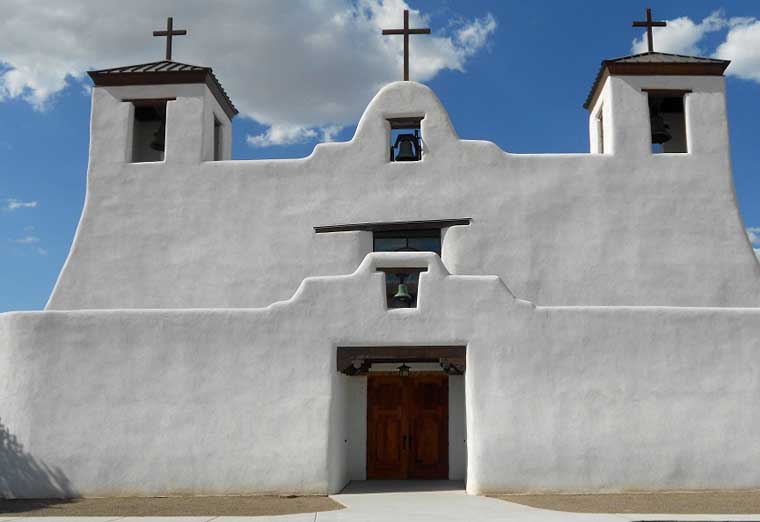
Isleta Pueblo was founded in the 1300s. Archaeologists have put forth various ideas as to where the people came from with some scholars saying they migrated north from Mogollon/Mimbres settlements to the south while others say they migrated southeastward from either Chaco Canyon in the 1100s and 1200s or from the Four Corners area in the 1200s and 1300s. There is every possibility they are an indigenous Tano population that was merged with Aztec migrants coming north from central Mexico and they were never part of the Chacoan world. Their Tiwa language is shared with nearby Sandia Pueblo and a very similar tongue is spoken to the north at Taos and Picuris Pueblos. The two dialects are sometimes referred to as Southern and Northern Tiwa. The Taos people also consider that some of their ancestors migrated north from Aztec lands long ago while others came from the north.
When the Spanish arrived in the area they named the pueblo "Isleta" (meaning: island). The residents were relatively accommodating to the Spanish priests when compared to the reception the same priests got in other areas of Nuevo Mexico (making Isleta something of an "island of safety" for the Spanish in an ocean of hostility). When the Pueblo Revolt of 1680 happened, Isleta either couldn't or wouldn't participate in the rebellion.
When the Spanish governor was evicted from Santa Fe he went to Albuquerque, then to Isleta and gathered his troops. With warriors from the northern pueblos harassing their every move, none of the Spaniards wanted to go back and fight so when they left Isleta and headed south, many Isletans went south to the El Paso area with them. Those who went south were allowed to establish their own pueblo at Ysleta del Sur, a place that at the time was beyond the boundaries of the village of El Paso.
Other Isletans fled to the Hopi settlements in Arizona and returned after the fighting was clearly over, many with Hopi spouses. When the Spanish returned in 1682 they found the Isleta mission church burned and the main structure was being used as a livestock pen. When Don Diego de Vargas came in 1692 with troops intent on reconquering New Mexico, they found the whole village of Isleta empty and burned.
The governor ordered the pueblo be rebuilt and resettled so residents were brought in from Taos and Picuris to the north and from Ysleta del Sur to the south. By 1720 a new, more grandiose mission had been built on the foundations of the first.
Over the next century some dissident members of the Laguna and Acoma Pueblo communities migrated to Isleta. While they were welcomed into the main Isleta pueblo at first, friction developed over the years until in the late 1800s, the small communities of Oraibi and Chicale were established. Most of the newcomers moved to one or the other but some returned to Acoma and Laguna.
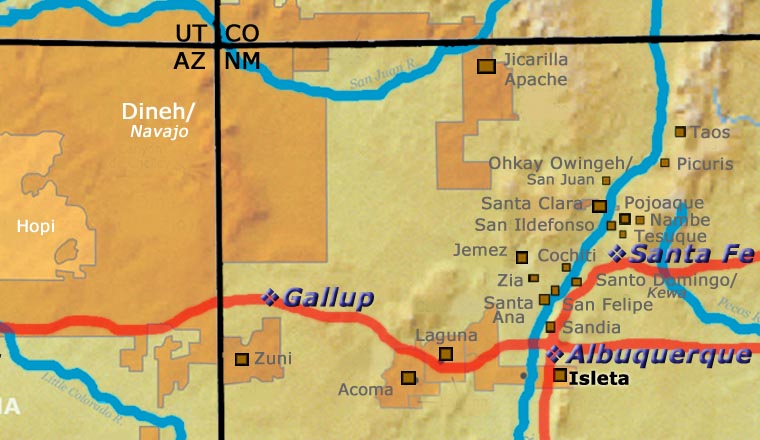
For more info:
Pueblo of Isleta at Wikipedia
Pueblo of Isleta official website
About Bowls
The bowl is a basic utilitarian shape, a round container more wide than deep with a rim that is easy to pour or sip from without spilling the contents. A jar, on the other hand, tends to be more tall and less wide with a smaller opening. That makes the jar better for cooking or storage than for eating from. Among the Ancestral Puebloans both shapes were among their most common forms of pottery.
Most folks ate their meals as a broth with beans, squash, corn, whatever else might be in season and whatever meat was available. The whole village (or maybe just the family) might cook in common in a large ceramic jar, then serve the people in their individual bowls.
Bowls were such a central part of life back then that the people of the Classic Mimbres society even buried their dead with their individual bowls placed over their faces, with a "kill hole" in the bottom to let the spirit escape. Those bowls were almost always decorated on the interior (mostly black-on-white, color came into use a couple generations before the collapse of their society and abandonment of the area). They were seldom decorated on the exterior.
It has been conjectured that when the great migrations of the 11th, 12th, 13th and 14th centuries were happening, old societal structures had to change and communal feasting grew as a means to meet, greet, mingle with and merge newly arrived immigrants into an already established village. That process called for larger cooking vessels, larger serving vessels and larger eating bowls. It also brought about a convergence of techniques, styles, decorations and design palettes as the people in each locality adapted. Or didn't: the people in the Gallina Highlands were notorious for their refusal to adapt and modernize for several hundred years. They even enforced a No Man's Land between their territory and that of the Great Houses of Chaco Canyon, killing any and all foreign intruders. Eventually, they seem to have merged with the Towa as those people migrated from the Four Corners area to the southern Jemez Mountains.
Traditional bowls lost that societal importance when mass-produced cookware and dishware appeared. But, like most other Native American pottery in the last 150 years, market forces caused them to morph into artwork.
Bowls also have other uses. The Zias and the Santo Domingos are known for their large dough bowls, serving bowls, hair-washing bowls and smaller chili bowls. Historically, these utilitarian bowls have been decorated on their exteriors. More recently, they've been getting decorated on the interior, too.
The bowl has also morphed into other forms, like Marilyn Ray's Friendship Bowls with children, puppies, birds, lizards and turtles playing on and in them. Or Betty Manygoats' bowls encrusted with appliqués of horned toads or Reynaldo Quezada's large, glossy black corrugated bowls with custom ceramic black stands.
When it comes to low-shouldered but wide circumference ceramic pieces (such as many Sikyátki-Revival and Hawikuh-Revival pieces are), are those jars or bowls? Conjecture is that the shape allows two hands to hold the piece securely by the solid body while tipping it up to sip or eat from the narrower opening. That narrower opening, though, is what makes it a jar. The decorations on it indicate that it is more likely a serving vessel than a cooking vessel.
This is where our hindsight gets fuzzy. In the days of Sikyátki, those potters used lignite coal to fire their pieces. That coal made a hotter fire than wood or manure (which wasn't available until the Spanish brought it). That hotter fire required different formulations of temper-to-clay and mineral paints. Those pieces were perhaps more solid and liquid resistant than most modern Hopi pottery is: many Sikyátki pieces survived intact after being slowly buried in the sand and exposed to the desert elements for hundreds of years. Many others were broken but were relatively easy to reassemble as their constituent pieces were found all in one spot and they survived the elements. Today's pottery, made the traditional way, wouldn't survive like that. But that ancient pottery might have been solid enough to be used for cooking purposes, back in the day.
About the Mimbres Culture
The Mimbres culture existed in the Mimbres Valley of southern New Mexico from about 850 CE to about 1150 CE. They were a sub-culture of the greater Mogollon culture that extended from the west coast of Mexico east across the Sierra Madre Mountains, north to the San Andres Mountains and northwest along the Mogollon Rim to the vicinity of today's Springerville, AZ.
North of the Gila Mountains was the influence of the Great Houses of the Chaco culture. Through comparisons of imagery and the colors used, it has been conjectured that Chaco was a more male dominant society while Mimbres was more female dominant. Both areas were settled, built, flowered and abandoned on almost exactly the same time schedules. But at the time of abandonment, the folks of Chaco mostly moved north while those of the Mimbres valley mostly went south.
The Mimbres people were among the first cultures that evolved their own forms of imagery and means of telling stories through those images. The Classic Mimbres period was the height of their creativity, from about 1000 CE to about 1150 CE. Then things changed and migrations began in earnest. Many moved south and brought some of their art to Paquimé. Others pushed north and then west, around the Gila Mountains. By 1200 CE the vast majority of the people in the area of the Mimbres Valley had moved elsewhere.
Most Mimbres pottery was black-on-white. Around 1120 CE there was an influx of migrants from Hohokam and Salado areas to the west. That's about when the first black-on-red pottery appeared in the Mimbres villages. Some of the imagery we see today from many of the Northern and Middle Rio Grande pueblos had its origins in the Mimbres Valley.
Substantial depopulation of the area occurred shortly after 1150 CE but there were many small surviving populations scattered around. Over time, these melted into the surrounding cultures with many families moving north to Acoma, Zuni and Hopi while others moved south to Casas Grande and Paquimé.
The greater Mogollon culture spanned the countryside from the west coast of Mexico east across the Sierra Madre to Paquimé, then north through the Mimbres Valley to the edge of the White Sands and then northwest along the Mogollon Rim into east-central Arizona.
The time period from about 850 CE to about 1000 CE is classed the Late Basketmaker III period across the Southwest. The time period was characterized by the evolution of square and rectangular pithouses with plastered floors and walls. Ceremonial structures were generally dug deep into the ground. In the Mimbres Valley area, local forms of pottery have been classified as early Mimbres black-on-white (formerly Boldface Black-on-White), textured plainware and red-on-cream.
The Classic Mimbres phase (1000 CE to 1150 CE) was marked with the construction of larger buildings in clusters of communities around open plazas. Some constructions had up to 150 rooms. Most groupings of rooms included a ceremonial room, although smaller square or rectangular underground kivas with roof openings were also being used. Classic Mimbres settlements were located in areas with well-watered floodplains available, suitable for the growing of maize, squash and beans. The villages were limited in size by the ability of the local area to grow enough food to support the village.
Pottery produced in the Mimbres region is distinct in style and decoration. Early Mimbres black-on-white pottery was primarily decorated with bold geometric designs, although some early pieces show human and animal figures. Over time the rendering of figurative and geometric designs grew more refined, sophisticated and diverse, suggesting community prosperity and a rich ceremonial life. Classic Mimbres black-on-white pottery is also characterized by bold geometric shapes executed with refined brushwork and very fine linework. Designs may include figures of one or more humans, animals or other shapes, bounded by either geometric decorations or by simple rim bands. A common figure on a Mimbres pot is the turkey, others are the thunderbird, rabbit and various anthropomorphic, half-human figures. There are also a lot of different fish depicted, some are species found only in the Gulf of California (hundreds of miles away across the desert).
A lot of Mimbres bowls (with kill holes) have been found in archaeological excavations but most Mimbres pottery shows evidence it was actually used in day-to-day life and wasn't produced just for burial purposes.
There's a lot of speculation as to what happened to the Mimbres people as their countryside was rapidly depopulated after about 1150 CE. The people of Isleta, Acoma and Laguna find ancient Mimbres pot shards on their pueblo lands, indicating that pottery designs from the Mimbres River area migrated north. There are similar designs found on pot shards littering the ground around Casas Grandes and Paquimé near Mata Ortiz and Nuevo Casas Grandes in northern Mexico. Other than where they went, the only reasons offered for why they left involve at least small scale climate change. The usual comment is "drought" but drought could have been brought on by the eruption of a volcano on the other side of the planet, or a small change in the El Nino-La Nina schedule. Whatever it was that started the outflow of people, it began in the Mimbres River area and spread outward from there. Excavations in the eastern Mimbres region (nearer to Truth or Consequences, New Mexico) have shown that the people adapted to new circumstances and that adaptation itself moved them closer into alignment with surrounding villages and cultures. Eventually they just kind of merged into the background population.
The groups that moved south and built up Paquimé and Casas Grandes became powerful and wealthy over the next couple hundred years. Then they seem to have lost a war in the mid-1400s and the survivors were forced to migrate to the west, to a land a bit more hospitable for them at the time. It's also quite possible that they were defeated by volcanic eruptions on the other side of the planet: the 1100s, 1200s and 1300s were a time of migration in many parts of the world because of continuing bad weather events. The Little Ice Age that saw temperatures in the Northern Hemisphere drop as much as 2°C began in the early 1300s and lasted into the mid 1800s. NASA feels that this was mostly a result of large volumes of volcanic aerosols being pumped into the atmosphere at the time.

